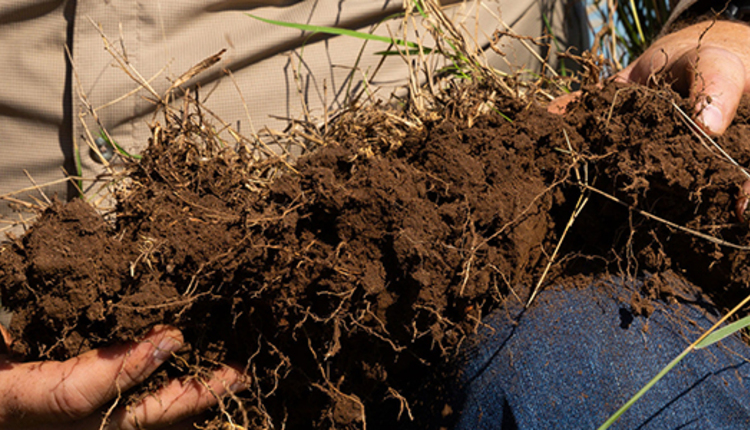
Soil health is a complex concept. In the realm of regenerative agriculture, soil carbon is believed to be one of the most important measures of restoring soil health. Noble Research Institute’s Larry York and Jeff Goodwin recently explained in the Noble News and Notes newsletter the steps you can take to improve a soil’s carbon content and overall health.
Without using soil samples and lab tests, carbon content can be observed by the look and smell of a soil. Soils with high carbon content tend to be darkly colored and have a rich, earthy scent. Some of the benefits of an improved carbon content include greater water filtration and enhanced water retention.
Before you can build soil health, you need to understand the basics of carbon cycling. Roots take up water and minerals from the soil around them. In turn, they release many different compounds known as root exudates that range from mucilage to small molecules like sugars. This continual exchange fuels the soil’s microbial community.
There are two types of carbon content present in the soil. One is particulate organic matter, which is made of larger fragments and is believed to be shorter lived. Mineral-associated organic matter, the second type, is made of smaller molecules bound to soil mineral particles.
So, how can we build soil health and soil carbon content? York and Goodwin suggest the following as good starting points:
- Keep soils protected and covered. Plant litter and living shoots act to conserve soil moisture and regulate temperature.
- Avoid tillage when possible. Tillage exposes fresh soil to the surface, which creates a burn-off effect when the soil carbon becomes exposed to oxygen in the atmosphere. The microbial community consumes the carbon for energy and expels it in the form of carbon dioxide.
- Reduce disturbances to soil structure. Any kind of disturbance to the soil’s physical structure can compromise mineral surfaces, which serve as carbon binding sites. The natural activities of roots, microbes, and soil biology all lead to greater porosity with regenerative capacity. Minimizing the number of tillage passes you make over a field is one way to reduce structural disturbances.
- Increase plant biodiversity. By expanding the types of plants grown that also have different growing seasons, you are able to create a continual supply of live and dead roots in the soils. This will supply more organic matter to the soil throughout the year as opposed to only having one crop, and the natural exchange of carbon between the root systems and microbial community will continue year-round as well.
- Livestock can aid in soil health, too. Livestock can promote plant and root growth if the forages are not over-grazed. Manure is also another rich source of soil carbon.
The Noble Research Institute defines regenerative agriculture as the process of restoring degraded soils using practices based on ecological principles. Soil health has become a rallying point for many people involved with regenerative agriculture, including researchers, food companies, and producers.

C.J. Weddle served as the 2020 Hay & Forage Grower editorial intern. She currently attends Mississippi State University, majoring in agricultural education, leadership, and communications. She grew up on a farm in Vardaman, Miss., where her family raises sweet potatoes and soybeans.

